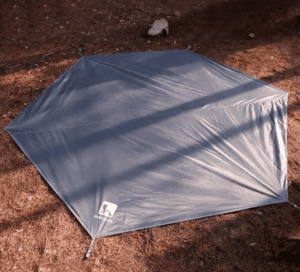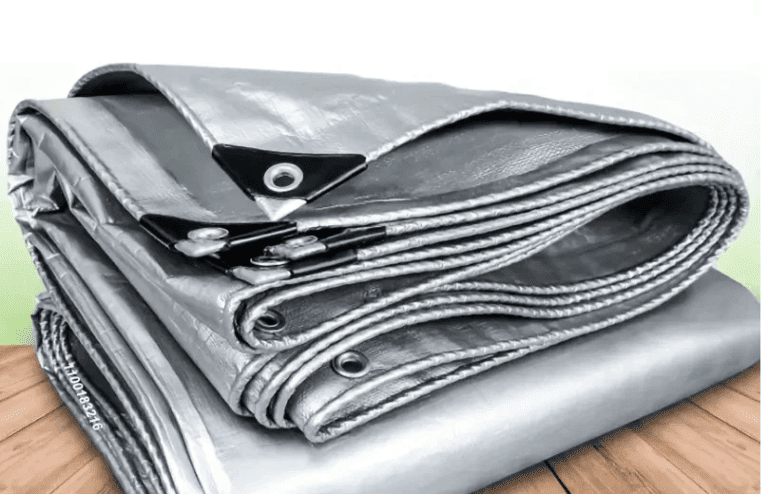Footprint Tent vs Tarp:
Which is Better for Camping?
Falling asleep to the sound of rain falling on your tent is very soothing, but waking up to cold fingers of water soaking through your sleeping bag in the wee morning hours is another thing entirely. Make sure you stay dry and comfortable on your next camping trip with the right gear!
When planning a camping trip, choosing the right gear is essential for both comfort and durability in the great outdoors.
Among the vast array of equipment choices, the decision between a tent footprint and a tarp stands out as particularly important. Both serve to protect the tent floor of your camping setup, but they cater to different needs and preferences.
This guide dives into the nuances of tent footprints and tarps, helping you make an informed decision on which is better suited for your camping adventures.
Defining Tent Footprints and Tarps
A Tent Footprint or footprint tent is a specific, custom-shaped ground cloth designed to fit under a tent to protect its floor from abrasion, punctures, and moisture. Made from durable, lightweight materials like polyethylene, polyester, or Tyvek, it is water-resistant and crafted to extend the lifespan of a tent by acting as a barrier between the tent floor and the ground.

A tent footprint is:
- tailored to fit a tent’s shape
- guards against ground-induced wear and moisture
- valuable for tent preservation and dryness
- lightweight, compact
- fits perfectly under the tent
A Tarp is a versatile, multipurpose sheet made from materials such as vinyl, canvas, or rubber, used for various outdoor applications. Tarps vary in durability and water resistance, with some being heavy-duty and waterproof, making them suitable for a wide range of weather conditions and outdoor uses.

A tarp can be used as:
- weather shield or shade providers
- a rain fly
- privacy barriers
- extra layer of ground cover
- emergency shelter
Practical Considerations for Campers
When it comes to choosing between a footprint tent and a tarp for your camping needs, there are a few practical considerations to keep in mind. Here are some factors to consider before making your decision:
Material, Durability, Weather Resistance
| Attribute | Footprints | Tarps |
|---|---|---|
| Material | Polyethylene, Polyurethane-coated ripstop nylon or polyester | Vinyl, Canvas, Polyethylene, Rubber |
| Durability | High resistance against tearing and wear from rugged terrain | Varies; generally more durable but heavier and bulkier |
| Weather Resistance | Water-resistant, maintains tent dryness in damp conditions | Waterproof options available; superior with vinyl and rubber, less so with canvas |
NOTE: Tarps used under your tent must be all the way under the “footprint” of your tent floor. When tarps extend beyond the tent floor, water that drips off the tent will then flow down onto the tarp and collect rain under the tent making your situation worse.
Weight and Portability
If you’re backpacking or someone who likes to keep things lightweight, a Tent Footprint is an excellent choice. A car camper with plenty of space for camping gear might find a tarp very suitable.
- Footprints are made of lightweight materials, often weighing 8oz or less, and can be easily packed into a small space, making them ideal for backpacking trips.
- Tarps tend to be heavier and bulkier, which can be a concern if you’re trying to keep your backpack weight down.
Ease of Use and Versatility
Check out the pros and cons of footprint tents and tarps below.
Tent Footprint
| Feature | Pros | Cons |
|---|---|---|
| Ease of Setup | Easier to set up; aligns with tent poles for efficiency. | Limited to specific tent shapes; not as versatile. |
| Versatility | Ready-sized for specific tents. | Fewer grommets for staking, limiting alternate uses. |
| Size & Adaptability | Matches the tent’s footprint exactly. | Smaller than tarps, limiting coverage area. |
Tarp
| Feature | Pros | Cons |
|---|---|---|
| Ease of Setup | Can be set up in various configurations for flexibility. | More challenging to set up, especially in windy conditions. |
| Versatility | Offers larger coverage and is adaptable to needs. | Difficult to fit under non-square or non-rectangular tents. |
| Size & Adaptability | Offers larger coverage and adaptable to needs. | Size and shape may not match all tents. |
Size and Customization Options
Footprints are frequently made by tent manufacturers for a custom fit for each tent model. However, if you want to customize your camping setup, a tarp may be a better choice. With a tarp, you can adjust the size and configuration to suit your needs, whether you’re looking for more coverage or less.
Cost and Long-Term Value
When it comes to choosing between a footprint tent and a tarp, cost and long-term value are factors to consider.
Initial Investment vs. Lifespan
The initial investment for most tarps is generally comparable to that of a footprint tent. However, a footprint tent is custom-designed to last for years, while a tarp may only last for a season or two, depending on the quality. This means that while a tarp may be a more affordable option in the short term, a footprint tent may provide better long-term value.
| Item | Cost Range |
|---|---|
| Tent Footprint | $15 – $80 |
| 8×8’ Poly Tarp | $14 – $22 |
| 8×8’ Vinyl Coated Polyester Tarp | $66 |
| 8×8’ Polyester Canvas Tarp | $82 |
Repair and Maintenance
Both footprint tents and tarps may require repair and maintenance over time. The key is what material your Footprint for Tarp are made from. A tarp may need to be patched or replaced entirely if it becomes damaged, while a tent footprint can often be repaired with a simple patch kit.
Environmental Factors and Terrain
When it comes to choosing between a footprint tent and a tarp, there are several environmental factors and terrain considerations that you should keep in mind. Here are some of the most important factors to consider:
Ground Conditions and Tent Placement
Rough Ground: The tent footprint is the clear winner for a camp on rough terrain. Many footprints have grommets that line up exactly with your tent poles and stay in place on rough or uneven ground.
Flat Ground: There is no significant difference other than the slight added effort to use a tarp, making sure that it stays under the tent.
Frozen Ground: A tarp with a smooth surface is preferred over ground cloth. Fabric textures stick more firmly to frozen ground and are harder to remove than blue poly-tarp or rubberized tarp.
DIY Solutions and Customization
When it comes to camping gear, sometimes the best solution is the one you create yourself. With footprint tents and tarps, there are plenty of opportunities for DIY solutions and customization that can save you money and provide a unique camping experience.
Creating Your Own Footprints and Tarps
For a DIY footprint, take a short trip to a hardware store for tarp or waterproof material like DuPont’s Tyvek . You can cut them to be slightly smaller than the dimensions of your tent. This will prevent the edges of the tarp from collecting water and potentially causing leaks in your tent. You can then use a grommet kit to insert grommets at the corners and edges of the tarp, making it easier to secure to the ground with tent stakes.
Utilizing Grommets and Modifications
If you already have a footprint or tarp but want to make it more functional, utilizing grommets can be a great solution. With a grommet kit, you can easily add holes carrying handles or reinforced corners to your tarp or footprint. Make it easier to transport your gear and ensure that your footprint or tarp holds up to the wear and tear of multiple camping trips.
Folding it up
Overall, both footprint tents and tarps have their advantages and disadvantages, and the choice ultimately comes down to your personal preferences and needs. Consider the factors above when making your decision, and choose the option that best suits your camping style.
While a tarp may be an inexpensive initial investment, a footprint tent may provide better long-term value due to its durability and ease of setup.
DIY solutions can also be a great way to save money and create a unique piece of camping gear. Whether you’re creating your own footprint or modifying an existing tarp, there are plenty of opportunities for customization that can make your camping trip more enjoyable.
Bottom line: If you want ease of set up and lightweight durability, go with a tent footprint. If weight and set-up speed are not a concern and you want multipurpose versatility, choose the tarp.
Frequently Asked Questions
What are the advantages of using a tent footprint over a tarp?
One of the main advantages of using a tent footprint is that it is specifically designed to fit the dimensions of your tent, providing a perfect fit. This helps to protect the bottom of your tent from wear and tear, as well as from moisture and dirt. A tent footprint can also help to increase the lifespan of your tent by preventing damage to the bottom of the tent.
How does a ground tarp differ from a tent footprint for camping?
A ground tarp is a more general-purpose camping accessory that can be used for a variety of purposes, including as a ground cover for your tent. However, a ground tarp is not specifically designed to fit the dimensions of your tent, so it may not provide the same level of protection as a tent footprint. Additionally, a ground tarp may be more difficult to secure in place under your tent, which can lead to it shifting or bunching up during use.
Can a tent footprint also serve as an effective rain tarp?
While a tent footprint is designed to provide protection for the bottom of your tent, it is not specifically designed to be used as a rain tarp. Footprints are generally smaller, made from lightweight materials, and not as waterproof as dedicated rain tarps. If you need protection from rain, it is recommended that you use a dedicated rain tarp.
What should be considered when choosing the size of a tent footprint or tarp?
When choosing the size of your tent footprint or tarp, it is important to consider the dimensions of your tent, as well as the terrain and weather conditions in which you will be camping. You will want to choose a size that is slightly smaller than the base of your tent to ensure a good fit, but not so small that it does not provide adequate protection. Additionally, you will want to choose a size that is appropriate for the terrain and weather conditions in which you will be camping.
Are tent footprints designed to be waterproof?
While tent footprints are generally made from water-resistant materials, they are not designed to be completely waterproof. Tent footprints are designed to protect the bottom of your tent from moisture and dirt, but they may not be able to withstand heavy rain or standing water. If you need protection from heavy rain, it is recommended that you use a dedicated rain tarp.
What is the best way to position a tarp under a tent for rain protection?
When positioning a tarp under your tent for rain protection, it is important to ensure that the tarp is slightly smaller than the base of your tent. This will help to prevent water from pooling on top of the tarp and seeping into your tent.



